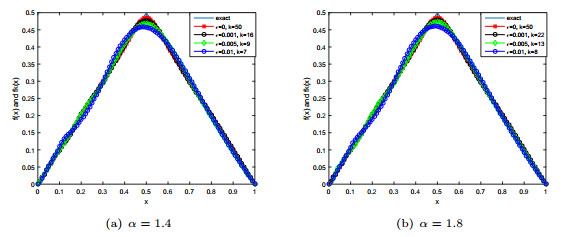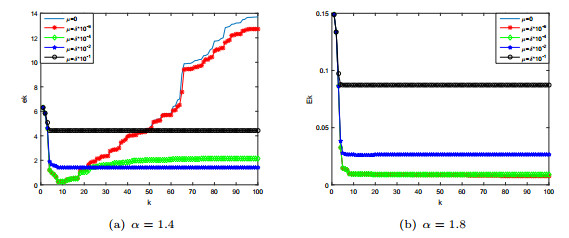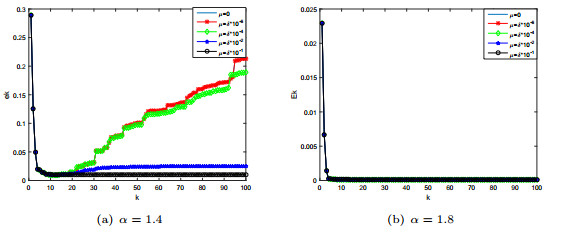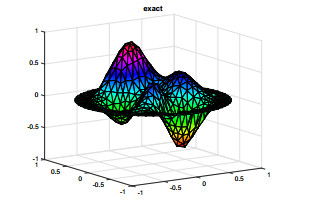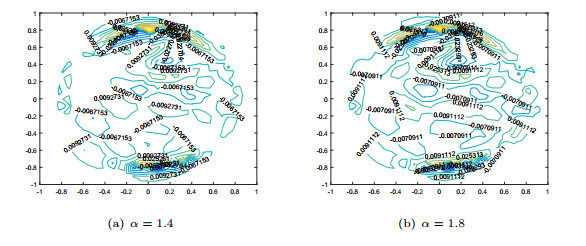|
[1]
|
O. P. Agrawal, Solution for a fractional diffusion-wave equation defined in a bounded domain, Nonlinear Dynam., 2002, 29(1-4), 145-155. Fractional order calculus and its applications.
Google Scholar
|
|
[2]
|
B. Berkowitz, H. Scher and S. E. Silliman, Anomalous transport in laboratory-scale, heterogeneous porous media, Water Resources Research, 2000, 36(1), 149-158. doi: 10.1029/1999WR900295
CrossRef Google Scholar
|
|
[3]
|
A. Chen and C. P. Li, Numerical solution of fractional diffusion-wave equation, Numer. Funct. Anal. Optim., 2016, 37(1), 19-39.
Google Scholar
|
|
[4]
|
G. Chi, G. Li and X. Jia, Numerical inversions of a source term in the FAD with a Dirichlet boundary condition using final observations, Comput. Math. Appl., 2011, 62(4), 1619-1626. doi: 10.1016/j.camwa.2011.02.029
CrossRef Google Scholar
|
|
[5]
|
H. Y. Dai, L. L. Wei and X. D. Zhang, Numerical algorithm based on an implicit fully discrete local discontinuous Galerkin method for the fractional diffusion-wave equation, Numer. Algorithms, 2014, 67(4), 845-862. doi: 10.1007/s11075-014-9827-y
CrossRef Google Scholar
|
|
[6]
|
R. Du, W. R. Cao and Z. Z. Sun, A compact difference scheme for the fractional diffusion-wave equation, Appl. Math. Model., 2010, 34(10), 2998-3007. doi: 10.1016/j.apm.2010.01.008
CrossRef Google Scholar
|
|
[7]
|
H. W. Engl, M. Hanke and A. Neubauer, Regularization of inverse problems, 375 of Mathematics and its Applications, Kluwer Academic Publishers Group, Dordrecht, 1996.
Google Scholar
|
|
[8]
|
K. Fujishiro and Y. Kian, Determination of time dependent factors of coefficients in fractional diffusion equations, Math. Control Relat. Fields, 2016, 6(2), 251-269. doi: 10.3934/mcrf.2016003
CrossRef Google Scholar
|
|
[9]
|
D. Fujiwara, Concrete characterization of the domains of fractional powers of some elliptic differential operators of the second order, Proc. Japan Acad., 1967, 43(2), 82-86. doi: 10.3792/pja/1195521686
CrossRef Google Scholar
|
|
[10]
|
D. J. Jiang, Z. Y. Li, Y. K. Liu and M. Yamamoto, Weak unique continuation property and a related inverse source problem for time-fractional diffusion-advection equations, Inverse Problems, 2017, 33(5), 055013, 22. doi: 10.1088/1361-6420/aa58d1
CrossRef Google Scholar
|
|
[11]
|
H. Jiang, F. Liu, I. Turner and K. Burrage, Analytical solutions for the multi-term time-fractional diffusion-wave/diffusion equations in a finite domain, Comput. Math. Appl., 2012, 64(10), 3377-3388. doi: 10.1016/j.camwa.2012.02.042
CrossRef Google Scholar
|
|
[12]
|
Y. J. Jiang and J. T. Ma, High-order finite element methods for time-fractional partial differential equations, Journal of Computational and Applied Mathematics, 2011, 235(11), 3285-3290. doi: 10.1016/j.cam.2011.01.011
CrossRef Google Scholar
|
|
[13]
|
B. T. Jin, R. Lazarov, Y. K. Liu and Z. Zhou, The Galerkin finite element method for a multi-term time-fractional diffusion equation, J. Comput. Phys., 2015, 281, 825-843. doi: 10.1016/j.jcp.2014.10.051
CrossRef Google Scholar
|
|
[14]
|
Y. Kian, L. Oksanen, E. Soccorsi and M. Yamamoto, Global uniqueness in an inverse problem for time fractional diffusion equations, J. Differential Equations, 2018, 264(2), 1146-1170. doi: 10.1016/j.jde.2017.09.032
CrossRef Google Scholar
|
|
[15]
|
Y. Kian and M. Yamamoto, On existence and uniqueness of solutions for semilinear fractional wave equations, Fract. Calc. Appl. Anal., 2017, 20(1), 117-138.
Google Scholar
|
|
[16]
|
A. Kilbas, H. Srivastava and J. Trujillo, Theory and applications of fractional differential equations, Elsevier, Amsterdam, 2006.
Google Scholar
|
|
[17]
|
C. P. Li and F. H. Zeng, Finite difference methods for fractional differential equations, Internat. J. Bifur. Chaos Appl. Sci. Engrg., 2012, 22(4), 1230014, 28. doi: 10.1142/S0218127412300145
CrossRef Google Scholar
|
|
[18]
|
L. M. Li, D. Xu and M. Luo, Alternating direction implicit Galerkin finite element method for the two-dimensional fractional diffusion-wave equation, J. Comput. Phys., 2013, 255, 471-485. doi: 10.1016/j.jcp.2013.08.031
CrossRef Google Scholar
|
|
[19]
|
Y. K. Liu, W. Rundell and M. Yamamoto, Strong maximum principle for fractional diffusion equations and an application to an inverse source problem, Fract. Calc. Appl. Anal., 2016, 19(4), 888-906.
Google Scholar
|
|
[20]
|
A. Lopushansky and H. Lopushanska, Inverse source Cauchy problem for a time fractional diffusion-wave equation with distributions, Electron. J. Differential Equations, 2017, Paper No. 182, 14.
Google Scholar
|
|
[21]
|
Y. Luchko, Maximum principle for the generalized time-fractional diffusion equation, J. Math. Anal. Appl., 2009, 351(1), 218-223.
Google Scholar
|
|
[22]
|
Y. Luchko, Some uniqueness and existence results for the initial-boundary-value problems for the generalized time-fractional diffusion equation, Comput. Math. Appl., 2010, 59(5), 1766-1772. doi: 10.1016/j.camwa.2009.08.015
CrossRef Google Scholar
|
|
[23]
|
R. Metzler and J. Klafter, The random walk's guide to anomalous diffusion: a fractional dynamics approach, Phys. Rep., 2000, 339(1), 1-77.
Google Scholar
|
|
[24]
|
D. A. Murio, Implicit finite difference approximation for time fractional diffusion equations, Comput. Math. Appl., 2008, 56(4), 1138-1145. doi: 10.1016/j.camwa.2008.02.015
CrossRef Google Scholar
|
|
[25]
|
A. Pazy, Semigroups of linear operators and applications to partial differential equations, Springer-Verlag, Berlin, 1983.
Google Scholar
|
|
[26]
|
I. Podlubny, Fractional differential equations, Academic Press, San Diego, 1999.
Google Scholar
|
|
[27]
|
Z. S. Ruan, Z. J. Yang and X. L. Lu, An inverse source problem with sparsity constraint for the time-fractional diffusion equation, Adv. Appl. Math. Mech., 2016, 8(1), 1-18. doi: 10.4208/aamm.2014.m722
CrossRef Google Scholar
|
|
[28]
|
K. Sakamoto and M. Yamamoto, Initial value/boundary value problems for fractional diffusion-wave equations and applications to some inverse problems, J. Math. Anal. Appl., 2011, 382(1), 426-447.
Google Scholar
|
|
[29]
|
M. Slodička and K. Šišková, An inverse source problem in a semilinear time-fractional diffusion equation, Comput. Math. Appl., 2016, 72(6), 1655-1669.
Google Scholar
|
|
[30]
|
Z. Z. Sun and X. N. Wu, A fully discrete difference scheme for a diffusion-wave system, Appl. Numer. Math., 2006, 56(2), 193-209. doi: 10.1016/j.apnum.2005.03.003
CrossRef Google Scholar
|
|
[31]
|
K. Šišková and M. Slodička, Recognition of a time-dependent source in a time-fractional wave equation, Appl. Numer. Math., 2017, 121, 1-17.
Google Scholar
|
|
[32]
|
W. Y. Wang, M. Yamamoto and B. Han, Numerical method in reproducing kernel space for an inverse source problem for the fractional diffusion equation, Inverse Prob., 2013, 29(9), 095009. doi: 10.1088/0266-5611/29/9/095009
CrossRef Google Scholar
|
|
[33]
|
T. Wei, X. L. Li and Y. S. Li, An inverse time-dependent source problem for a time-fractional diffusion equation, Inverse Problems, 2016, 32(8), 085003, 24. doi: 10.1088/0266-5611/32/8/085003
CrossRef Google Scholar
|
|
[34]
|
T. Wei and J. G. Wang, A modified quasi-boundary value method for an inverse source problem of the time-fractional diffusion equation, Applied Numerical Mathematics, 2014, 78(4), 95-111.
Google Scholar
|
|
[35]
|
X. B. Yan and T. Wei, Inverse space-dependent source problem for a time-fractional diffusion equation by an adjoint problem approach, J. Inverse Ill-Posed Probl., 2019, 27(1), 1-16. doi: 10.1515/jiip-2017-0091
CrossRef Google Scholar
|
|
[36]
|
F. H. Zeng, Second-order stable finite difference schemes for the time-fractional diffusion-wave equation, J. Sci. Comput., 2015, 65(1), 411-430. doi: 10.1007/s10915-014-9966-2
CrossRef Google Scholar
|
|
[37]
|
Y. Zhang and X. Xu, Inverse source problem for a fractional diffusion equation, Inverse Prob., 2011, 27(3), 035010. doi: 10.1088/0266-5611/27/3/035010
CrossRef Google Scholar
|




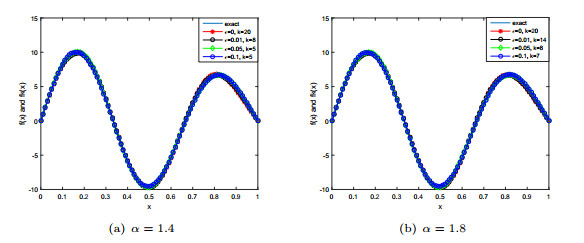

 DownLoad:
DownLoad:
